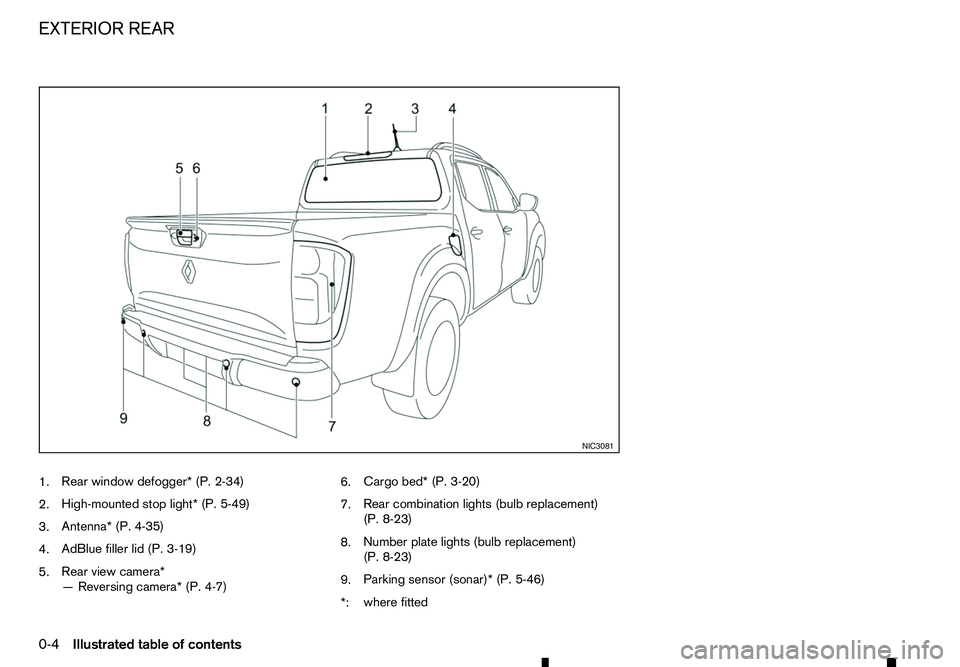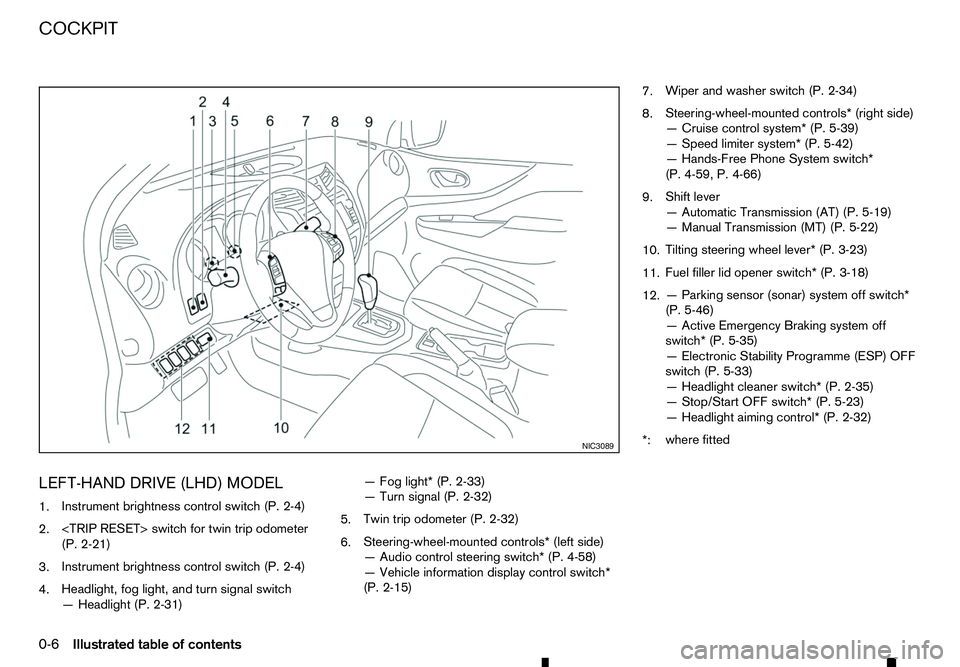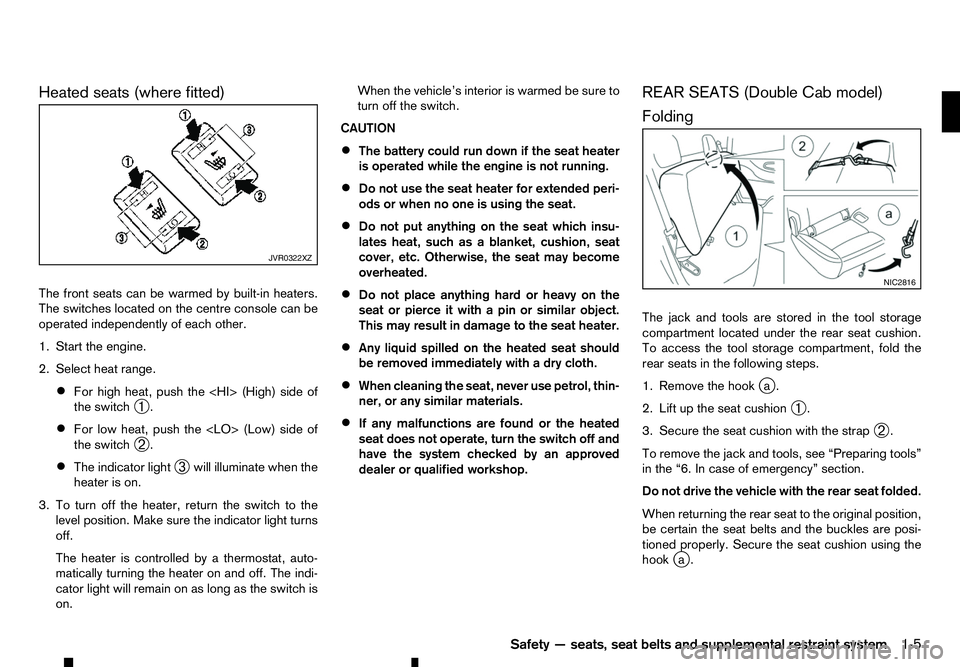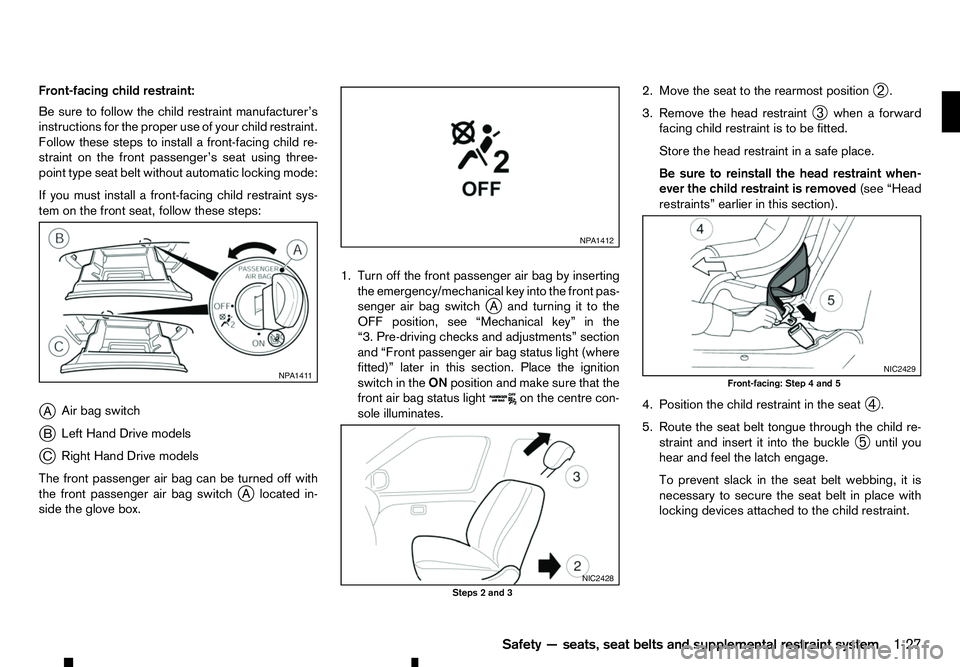light RENAULT ALASKAN 2017 Owners Manual
[x] Cancel search | Manufacturer: RENAULT, Model Year: 2017, Model line: ALASKAN, Model: RENAULT ALASKAN 2017Pages: 340, PDF Size: 6.93 MB
Page 9 of 340

1.
Bonnet (P. 3-17)
2. Windscreen wipers and washers
—S
witch operation (P. 2-34)
—W iper blade replacement (P. 8-16)
—W indow washer fluid (P. 8-11)
3. Sunroof*1 (P. 2-42)
4. Windows (P. 2-36) 5.
Roof rail*1 (P. 2-41)
6. Child safety rear door locks*1 (P. 3-5)
7. Doors
—K
eys (P. 3-2)
—D oor locks (P. 3-4)
—R emote keyless entry system*1 (P. 3-6)
—R emote Control Key system*1 (P. 3-7)
—S ecurity system*1 (P. 3-15) 8.
Outside rearview mirrors (P. 3-25)
9. Side turn signal lights
—B
ulb replacement (P. 8-23)
10. Tyres
—T
yres and wheels (P. 8-26)
—F lat tyre (P. 6-2)
—S pecifications (P. 9-4)
—F our-Wheel Drive (4WD)*1 (P. 5-32)
11. Headlights and turn signal lights
—S
witch operation (P. 2-31)
—B ulb replacement (P. 8-21)
12. Headlight cleaner*1
—O
peration (P. 2-35)
13. Front fog lights*1 or Daytime running lights*1
—S
witch operation (P. 2-33, P. 2-31)
—B ulb replacement (P. 8-23)
14. Towing eye*2 (P. 6-13)
*1: where fitted
*2: The layout illustrated is for the Right-Hand
Drive (RHD) model. On the Left-Hand Drive
(LHD) model, the towing eye is located on the
opposite side. NIC3080
EXTERIOR FRONT
Illustrated table of contents0-3
Page 10 of 340

1.
Rear window defogger* (P. 2-34)
2. High-mounted stop light* (P. 5-49)
3. Antenna* (P. 4-35)
4. AdBlue filler lid (P. 3-19)
5. Rear view camera*
—R
eversing camera* (P. 4-7) 6.
Cargo bed* (P. 3-20)
7. Rear combination lights (bulb replacement)
(P. 8-23)
8. Number plate lights (bulb replacement)
(P. 8-23)
9. Parking sensor (sonar)* (P. 5-46)
*: where fitted NIC3081
EXTERIOR REAR
0-4 Illustrated table of contents
Page 11 of 340

1.
Inside rearview mirror (P. 3-23)
2. Sunglasses holder* (P. 2-40)
3. Microphone*
—B
luetooth® Hands-Free Phone System*
(P. 4-59, P. 4-65)
4. Sunroof switch* (P. 2-42)
5. Map lights (P. 2-43) 6.
Sun visors (P. 2-41)
7. Room light* (P. 2-44)
8. Rear personal light* (P. 2-45)
9. Console box* (P. 2-40)
—P
ower outlet (P. 2-38)
10. Cup holders* (P. 2-40) 11.
Door armrest
—P
ower window controls* (P. 2-36)
—P ower door lock switch (driver’s door)*
(P. 3-4)
—O utside rearview mirror remote control
switch (driver’s door)* (P. 3-25)
*: where fitted NIC2792
PASSENGER COMPARTMENT
Illustrated table of contents0-5
Page 12 of 340

LEFT-HAND DRIVE (LHD) MODEL
1. Instrument brightness control switch (P. 2-4)
2.
(P. 2-21)
3. Instrument brightness control switch (P. 2-4)
4. Headlight, fog light, and turn signal switch
—H
eadlight (P. 2-31) —F
og light* (P. 2-33)
—T urn signal (P. 2-32)
5. Twin trip odometer (P. 2-32)
6. Steering-wheel-mounted controls* (left side)
—A
udio control steering switch* (P. 4-58)
—V ehicle information display control switch*
(P. 2-15) 7.
Wiper and washer switch (P. 2-34)
8. Steering-wheel-mounted controls* (right side)
—C
ruise control system* (P. 5-39)
—S peed limiter system* (P. 5-42)
—H ands-Free Phone System switch*
(P. 4-59, P. 4-66)
9. Shift lever
—A
utomatic Transmission (AT) (P. 5-19)
—M anual Transmission (MT) (P. 5-22)
10. Tilting steering wheel lever* (P. 3-23)
11. Fuel filler lid opener switch* (P. 3-18)
12. —P
arking sensor (sonar) system off switch*
(P. 5-46)
—A ctive Emergency Braking system off
switch* (P. 5-35)
—E lectronic Stability Programme (ESP) OFF
switch (P. 5-33)
—H eadlight cleaner switch* (P. 2-35)
—S top/Start OFF switch* (P. 5-23)
—H eadlight aiming control* (P. 2-32)
*: where fitted NIC3089
COCKPIT
0-6
Illustrated table of contents
Page 13 of 340

RIGHT-HAND DRIVE (RHD) MODEL
1. Shift lever
—A
utomatic Transmission (AT) (P. 5-19)
—M anual Transmission (MT) (P. 5-22)
2. Steering-wheel-mounted controls* (left side)
—A
udio control steering switch* (P. 4-58)
—V ehicle information display control switch*
(P. 2-15) 3.
Wiper and washer switch (P. 2-34)
4. Steering-wheel-mounted controls* (right side)
—C
ruise control system* (P. 5-39)
—S peed limiter system* (P. 5-42)
—H ands-Free Phone System switch*
(P. 4-59, P. 4-66)
5. Instrument brightness control switch (P. 2-4) 6.
Headlight, fog light, and turn signal switch
—H
eadlight (P. 2-31)
—F og light* (P. 2-33)
—T urn signal (P. 2-32)
7. Twin trip odometer (P. 2-21)
8.
(P. 2-21)
9. Instrument brightness control switch (P. 2-4)
10. —H
eadlight aiming control* (P. 2-32)
—S top/Start OFF switch* (P. 5-23)
11. Electronic Stability Programme (ESP) OFF
switch* (P. 5-33)
12. —P
arking sensor (sonar) system off switch*
(P. 5-46)
—A ctive Emergency Braking system off
switch* (P. 5-35)
13. Fuel filler lid opener switch* (P. 3-18)
14. Tilting steering wheel lever* (P. 3-23)
*: where fitted NIC3090
Illustrated table of contents
0-7
Page 16 of 340

1.
Tachometer (P. 2-3)
2. Warning and indicator lights (P. 2-3)
3. Vehicle information display (P. 2-14)
—F
our-Wheel Drive (4WD) mode indicator*
(P. 5-30)
—O il control system* (P. 2-29)
—O dometer/twin trip odometer (P. 2-3)
—T rip computer (P. 2-21) —I
nstrument brightness control (P. 2-4)
—A utomatic Transmission (AT) position
indicator (AT model) (P. 2-28, P. 5-19)
4. Speedometer (P. 2-2)
5. Fuel gauge (P. 2-2)
6. Engine coolant temperature gauge (P. 2-3)
*: where fitted NIC2681
METERS AND GAUGES
0-10 Illustrated table of contents
Page 23 of 340

Heated seats (where fitted)
The front seats can be warmed by built-in heaters.
The switches located on the centre console can be
operated independently of each other.
1. Start the engine.
2. Select heat range. • For high heat, push the (High) side of
the switch
➀.
• For low heat, push the
Page 45 of 340

Front-facing child restraint:
Be sure to follow the child restraint manufacturer’s
instructions for the proper use of your child restraint.
Follow these steps to install afront-facing child re-
straint on the front passenger’s seat using three-
point type seat belt without automatic locking mode:
If you must install afront-facing child restraint sys-
tem on the front seat, follow these steps:
j A Air bag switch
j B Left Hand Drive models
j C Right Hand Drive models
The front passenger air bag can be turned off with
the front passenger air bag switch j
Al ocated in-
side the glove box. 1. Turn off the front passenger air bag by inserting
the emergency/mechanical key into the front pas-
senger air bag switch jAa nd turning it to the
OFF position, see “Mechanical key” in the
“3. Pre-driving checks and adjustments” section
and “Front passenger air bag status light (where
fitted)” later in this section. Place the ignition
switch in the ONposition and make sure that the
front air bag status light on the centre con-
sole illuminates. 2. Move the seat to the rearmost position
➁.
3. Remove the head restraint ➂when
aforward
facing child restraint is to be fitted.
Store the head restraint in asafe place.
Be sure to reinstall the head restraint when-
ever the child restraint is removed (see “Head
restraints” earlier in this section).
4. Position the child restraint in the seat ➃.
5. Route the seat belt tongue through the child re- straint and insert it into the buckle ➄until you
hear and feel the latch engage.
To prevent slack in the seat belt webbing, it is
necessary to secure the seat belt in place with
locking devices attached to the child restraint. NP A1411 NP A1412
NIC2428
Steps 2and 3 NIC2429
Front-facing: Step
4and 5
Safety —seats, seat belts and supplemental restraint system 1-27
Page 46 of 340

6. Remove any additional slack from the seat belt;
press downward ➅and rearward
j6a firmly in
the centre of the child restraint with your knee to
compress the vehicle seat cushion and seatback
while pulling up on the seat belt.
7. Test the child restraint before you place the child in it ➆.P
ush the child restraint from side to side
and tug it forward to make sure that it is held
securely in place. 8. Check to make sure that the child restraint is
properly secured prior to each use. If the child
restraint is loose, repeat steps 1through 7.
Rear-facing child restraint:
Be sure to follow the child restraint manufacturer’s
instructions for the proper use of your child restraint.
Follow these steps to install afront-facing child re-
straint on the front passenger’s seat using three-
point type seat belt without automatic locking mode:
If you must install arear-facing child restraint system
on the front seat, follow these steps:
j A Air bag switch
j B Left Hand Drive models
j C Right Hand Drive models
The front passenger air bag can be turned off with
the front passenger air bag switch jAl ocated in-
side the glove box. 1. Turn off the front passenger air bag by inserting
the emergency/mechanical key into the front pas-
senger air bag switch jA, see “Mechanical key”
in the “3. Pre-driving checks and adjustments”
section and “Front passenger air bag status light
(where fitted)” later in this section. Place the igni-
tion switch in the ONposition and make sure that
the front air bag status light on the centre
console illuminates.
2. Move the seat to the rearmost position ➁. NIC2430
Step 6
NIC2431
Step 7 NP A1411 NP A1412
NIC2428
Steps 2and 3
1-28 Safety —seats, seat belts and supplemental restraint system
Page 48 of 340

Supplemental side-impact air bag
system (where fitted)
This system can help cushion the impact force to
the chest and pelvis area of the driver and front pas-
senger in certain side-impact collisions. The supple-
mental side-impact air bag is designed to inflate on
the side where the vehicle is impacted.
Supplemental curtain side-impact air
bag system (where fitted)
This system can help cushion the impact force to
the head of the driver and passengers in front seat-
ing positions and rear outboard seating positions
(where fitted) in certain side-impact collisions. The
supplemental curtain side-impact air bag is designed
to inflate on the side where the vehicle is impacted.
The SRS is designed to supplementthe accident
protection provided by the driver’s and passenger’s
seat belts and is notdesigned to substitutefor
them. The SRS can help save lives and reduce seri-
ous injuries. However, inflating air bags may cause
abrasions or other injuries. Air bags do not provide
protection to the lower body. Seat belts should al-
ways be correctly worn and the occupants should
always be seated asuitable distance away from the
steering wheel, instrument panel and door finishers.
(See “Seat belts” earlier in this section.) The air
bags inflate quickly in order to help protect the oc-
cupants. The force of the air bags inflating can in-
crease the risk of injury if the occupants are too
close to, or are against, the air bag modules during
inflation. The air bags will deflate quickly after de-
ployment. The SRS operates only when the ignition switch
is in the ON position.
When the ignition switch is in the ON position,
the SRS air bag warning light illuminates for
about
7seconds and then turns off. This indi-
cates that the SRS is operational. (See “Warning
lights, indicator lights and audible reminders” in
the “2. Instruments and controls” section.)
1-30 Safety —seats, seat belts and supplemental restraint system